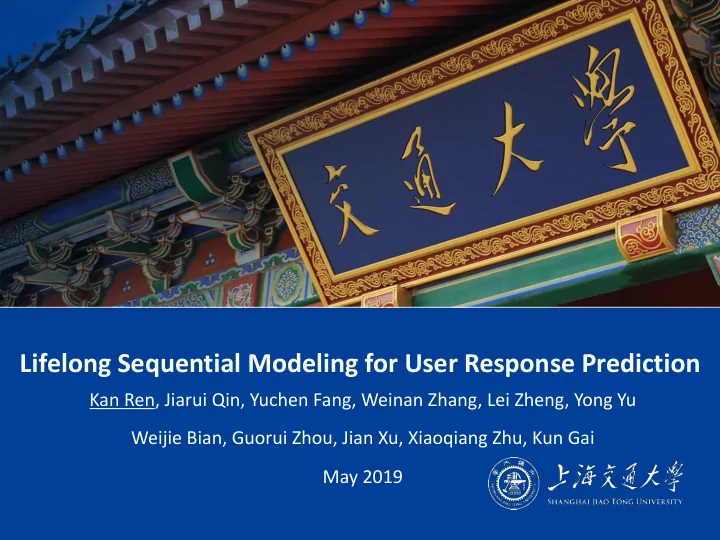

Lifelong Sequential Modeling for User Response Prediction ▪ Kan Ren, Jiarui Qin, Yuchen Fang, Weinan Zhang, Lei Zheng, Yong Yu ▪ Weijie Bian, Guorui Zhou, Jian Xu, Xiaoqiang Zhu, Kun Gai ▪ May 2019
User Response Prediction ▪ Predict the probability of positive user response ▪ Feature 𝒚 , including side-information and previous behaviors ▪ Label 𝑧 ▪ Output Pr(𝑧 = 1|𝒚) Response Type Prediction Goal Abbreviati on Click Click-through Rate CTR Conversion Conversion Rate CVR
Sequential Modeling for User Behaviors ▪ Sequential user modeling ▪ Conduct a comprehensive user profiling with the historical user behaviors and other side information and represent it in a unified framework. ▪ Usage ▪ User targeting in online advertising ▪ User behavior prediction ▪ Characteristics of user behaviors ▪ Intrinsic and multi-facet user interests ▪ Dynamic user interests and tastes ▪ Multi-scale sequential dependency within behavior history
Analysis of User Behaviors (Alibaba)
Related Works ▪ Aggregation-base methods: w/o considering sequential dependencies ▪ Matrix factorization (KDD’09) ▪ SVD and other variants (KDD’09, KDD’13) ▪ State-based methods: simple state and transition assumption ▪ Markov chain models (WWW’10, ICDM’16, RecSys’16) ▪ Deep learning methods: cannot handle long-term behavior sequences ▪ Recurrent neural network models (ICLR’16, CIKM’18) ▪ Convolutional neural network models (WSDM’18)
Lifelong Sequential Modeling ▪ Definition of Lifelong Sequential Modeling (LSM) ▪ LSM is a process of continuous (online) user modeling with sequential pattern mining upon the lifelong user behavior history. ▪ Characteristics ▪ supports lifelong memorization of user behavior patterns ▪ conducts a comprehensive user modeling of intrinsic and dynamic user interests ▪ continuous adaptation to the up-to-date user behaviors
Framework of LSM
HPMN Model ▪ Hierarchical Periodical Memory Network, HPMN
User Response Prediction ▪ Real-time query only on the maintained user memory ▪ w/o inference over the whole user behavior sequence online
R/W Operations ▪ The content in the 𝑘 -th memory slot at step 𝑗 / } /12 3 ▪ {𝒏 . ▪ Memory query and attentional reading ▪ Given the query vector of the target item 𝒘 ▪ Calculate the attention weight 𝑥 / = 𝐹 𝒏 / , 𝒘 for each 𝑘 -th memory slot 3 𝑥 / ⋅ 𝒏 / at step 𝑗 ▪ User representation 𝒔 = ∑ / ▪ Periodical and gate-based (soft) writing
HPMN Model Training ▪ Offline model training ▪ Online memory maintaining ▪ Loss functions ▪ Cross entropy loss ▪ Memory covariance regularization ▪ To enlarge covariance between each pair of memory slots ▪ Help deal with multi-facet user interests ▪ Parameter regularization
Experiment Setup ▪ Datasets short long Sequence length ▪ Evaluation metrics ▪ AUC ▪ Log-loss
Compared Models 1. Aggregation-based methods 1. DNN: utilizes sum-pooling for user behaviors 2. SVD++: latent factor model 2. Short-term behavior modeling methods 1. GRU4Rec: recurrent neural network model 2. Caser: convolutional neural network model 3. DIEN: dual RNN model w/ attention mechanism 4. RUM: key-value memory network model 3. Long-term behavior modeling methods 1. LSTM: long-short term memory model 2. SHAN: hierarchical attention-based model 3. HPMN: our model
Experiment Results
Visualized Analysis
Conclusion ▪ First work proposes lifelong sequential modeling ▪ Construct hierarchical periodical memory network to model long-term sequential dependency ▪ Dynamic read-write operations ▪ Significantly improved the performance ▪ Acknowledgement ▪ Alibaba Innovation Research (AIR) ▪ National Natural Science Foundation of China
Recommend
More recommend